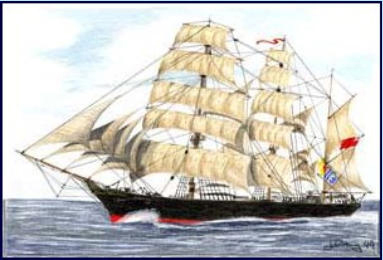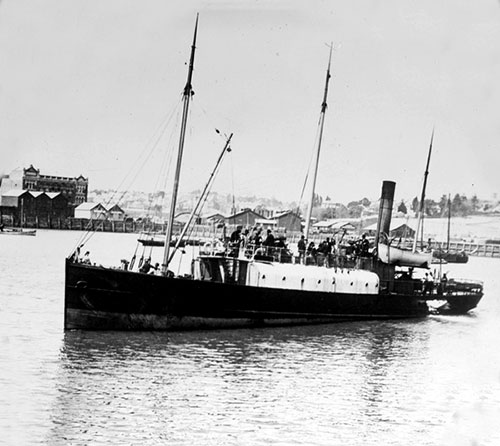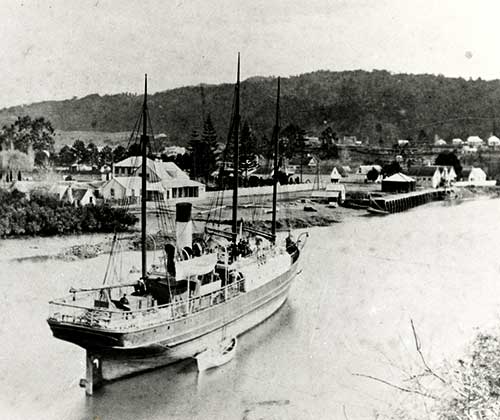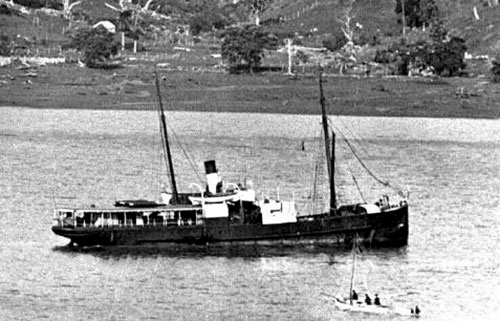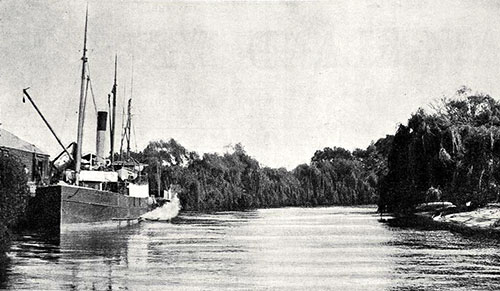The following is a transcription of a few pages of memoir written by my maternal great grandfather Alexander George Migan.
I was born in the year 1873 on an island in the Hauraki Gulf, just outside of Auckland Harbour. I am one of a family of 13 children, seven brothers and five sisters. We lived very close to the sea, and consequently we were always in it or on it for we as youngsters could swim like ducks, and we had a splendid rowing boat of our own, and therefore we had plenty of opportunities of learning to handle a small boat, which knowledge in after years became very handy to me. From the time I left school shortly after my father died I made up my mind to go to sea. I was just about 13 years old then. Of course there were plenty of opportunities for boys in the small timber craft on the coast at that time, and I had no trouble in finding one to make a start as a sailor in. We were paid by trip in the small coasters at that time. I got five shillings per trip, some times we could make two trips in a week and some times only one. It depended a lot on how far down the coast we had to go. We did not have to sign on in the coaster in those days. I got a good start off in one of the smartest cutters on the coast called ‘The Nellie’, and she could sail. Her main boom was 80 foot long. In later years they converted her into a ketch by putting another mast onto her. However she was my first as a boy. But it was not long before I tried some of the others and I was soon able to take my trick at the wheel with the rest of the crew. The crew consisted of four counting myself as ‘Boy’. Well, after being -??- in the Nellie I thought I had learnt enough to make me capable of taking another job with more money to it, so I packed my bag and went on shore from the Nellie.
I was not long ashore when I heard that the sister ship to the one I left was requiring a 3 hand. Incidentally a 3 hand had to act as cook. I had done a good bit of cooking on Nellie so I was prepared to have a go as third on the ‘Fanny’. Anyhow I thought there would be no harm done in having a try for it, so I wandered down to where the Fanny was discharging her timber. I asked if the skipper was on board. They said he was in the Cabin. So on board I went and met him coming on deck. I told him what I wanted and he asked me if I was able to cook. I told him I had done a fair bit of cooking. He then said ‘can you steer’?. ‘Yes’ says I. ‘All right’ says he ‘you can have the job, but if I find out that you can’t cook you will have to get off when we get back again’. Well as events proved I must have been able to cook for I stayed in her for 12 months. After that I went from one to other, until I had put in about three years in the mosquito fleet of sail. Afterwards I joined a Barque called the ‘Star of the East’ as OR* seaman. This is my first square rigged ship and it proved to be a very eventful day for me in more ways than one. We loaded a cargo of Kauri Gum for New York. My first critical moment was when I went to the shipping Office to sign on. I think I mentioned earlier that while I was in the small craft on the coast we did not have to sign on or off so consequently I had no discharge to show and I was afraid the old man would not take me. But my fears were quickly allayed when he called for an OR.
Did I ‘have a discharge’? ‘No’. ‘Have you been to sea before you were on the coast’? ‘How long’? ‘About three years’. ‘That will do, sign him on’. It was all settled in a few minutes. And I was an OR on board the Barque Star of the East. (For better or for worse). As it turned out it was for the better. She carried a crew of eight before the mast and two cadets. One of the Cadets named Wallace whom I became very friendly with while we were together in the ship. And incidentally I served with the same cadet some years after when I went into Steam. He was second officer in the old ‘Mokia’ of the USS Co. I served about l8 months, two voyages to New York and back to Auckland again. I forgot to mention that I had been promoted to AB after my first voyage in The Star of the East. It came as a bit of a surprise to me as I did not expect it so soon. It happened that one of the AB did not turn up when we were ready to sail so I was chosen to take his place, and signed on immediately as AB and one of the OR’s. So we were set again for another voyage to New York which happened to be my last in the good old S.O.T.E. (Star of the East) for which I often felt sorry for having had to leave her on our return to Auckland on my second voyage. I received word that my mother was very ill so I asked the old man to pay me off. And he did so. He was very decent about it too. He told me if I was onshore when they came back from New York again he would take me on again. I often think of Capt. Biss as one of the very few decent masters I served with in Sail in those days. As things turned out I did not go back in the S.O.T.E. I joined the crew of the Barque ‘Kathleen Hilda’. An old intercolonial timber trader for a number of years. I joined her about the time the Kauri Timber Co’s. Mills were going at full blast. And every old ship that was available at that time had no trouble in picking up a cargo for either Melbourne Sydney or Adelaide. And then to Newcastle for coals, back to Auckland. I was in the old Kathleen Hilda for nigh on two years. In that period we had one accident at sea. And as it happened to be my pal that was washed over board I felt it very much at the time. I there and then made up my mind to leave the K.H. when we arrived back in Auckland and having a look around doing odd jobs around the docks. And as usual keeping my weather eye open for anything that happened to come along that would suit me.
It was during this time on shore that a Barque called the ‘Astracarne’ put in to the port of Auckland in distress. She was bound for Cape Town. From New Caledonia she was heavily loaded with a cargo of nickle ore. On leaving New Caledonia she ran into a series of gales which shook her up considerably necessitating new yards, new top masts and a number of new sails. Anyhow she was a picture to look at. On the voyage from New Caledonia the old man had some trouble with his crew and the consequence was that a part of her crew were failed and those that were not failed cleared out from the ship. So the old man was in a bit of a dilemma. Having no crew to prepare his ship for sea again he had to get a gang of sailors from shore as riggers. Now I happened to know the firm of Paul & Hansen. They were General Ship Chandlers and Sailmakers, so I was one of eight sailors that was engaged to rig out the Astracarne again. Paul & Hanson the Ship Chandlers contracted to the job, so we were working on shore pay until she was ready for sea again, so I was quite content for the time being. It took us four weeks and three days to rig her out again with new spar and sails and new rigging were required. Well we finished our job preparing the Astracarne for sea again. And the contractors were very pleased with our work and so was the Old man. In fact he wanted to sign us on for the voyage to Cape Town. However, none of us wanted to sign on, so that settled it. And the old man had to scratch up some more men to make up for those that cleared out from the ship. Of course he had four or five men in jail waiting for the ship but whether they were taken back in the ship or not I never heard. All I know is that five days after we had finished on board of her she was still laying at anchor in the Stream.
And as it turned out it was the last I saw of ships for 6 months, for 5 of the 8 including myself of the eight that worked on the Astracarne got a job on shore, up country painting a railway bridge for the N.Z. Railways and it kept us busy for six months. Not that we finished painting and cleaning it for we did not. Most of us got fed up and after six months on the job decided to give someone else a go at it. I might mention that this particular bridge was fairly long, 380 feet, and the height from the centre of Bridge 160 feet. There was four sets of Bridge supports consisting of Angle Iron and Slap. You can just imagine what it was like hanging in a Boson’s chair all day brushing with a steel brush and then painting. I could not say which was the worst job, brushing the rust off or putting the paint on. I started off with a brand new suit of dungarees.
* Seaman Rankings: Leading Hand (LH), Able Bodied (AB), Ordinary Rating (OR)
Notes About Some Of The Ships Alexander Sailed On
The STAR Of The EAST
The barque Star Of The East was built by Charles Connell & Company Scotstoun. Yard No 102
Propulsion: Sail. 3 masts Launched: Thursday, 21/09/1876 Built: 1876 Ship Type: Iron barque Ship’s Role: Cargo Tonnage: 757 g / 734 n Length: 183.3 feet Breadth: 30.7 feet Depth: 18.5 feet Owner History: E. Smith, Plymouth. 1886: Sir R. W. Cameron, London. 1901: Barque Star of the East Co (R. F. Whitney, manager), Windsor NS. Status: Wrecked – 19/01/1907 Remarks: O.N. 74620. 19/10/1876: Registered at Plymouth. 19/01/1907: Wrecked at Axim, West Ghana.
Star Of The East, From New York
A familiar vessel to this port, the American trading barque Star of the East, Captain Rogers, arrived off the Heads last night, from New York, after a passage of 116 days. She was towed into the harbour by the Duchess this morning to await the usual health inspection. Her cargo consists of 210 tons general and 15,000 cases oil for Wellington, and there is a balance for Auckland, where she loads back to NewYork with kauri gum, etc. Messrs W. and G. Turnbull and Co are the local agents. The vessel has been sheltering under Kapiti.
Wreck Report for ‘Star of the East’, 1907
Excerpts from a Court of Inquiry held at Axim, Gold Coast Colony (now called West Ghana), on 9th February, 1907, under the provisions of Ordinance No. V. of 1903, to investigate the circumstances attending the stranding and loss of the British barque “Star of the East,” of Windsor, N.S. at the mouth of the Ancobra River, on 19th January, 1907.
After very carefully considering the evidence, the Court regrets to have to come to the following conclusion: ”That Captain Paul Le Blanc, master of the vessel “Star of the East,” in shaping a course from his position by observation at noon on January 18th to Axim erred in failing to allow sufficiently for the strong easterly current prevailing on this coast, and in the opinion of the Court the course he then set and steered, unless precautions were taken to verify it by frequent soundings, would probably ultimately lead to the vessel stranding before making Cape Three Points. Under all the circumstances of this case, as the Court is satisfied that the loss of this ship has been caused by the default of her master, Captain Paul Le Blanc, the Court orders that his certificate be suspended for a period of six months from this date. (Issued in London by the Board of Trade on the 16th day of April, 1907.)
The KATHLEEN HILDA
A stranger to this port in the shape of the new wooden, locally-owned barque, the Kathleen Hilda, Captain Davies, arrived to-day from Newcastle, coal-laden, after a very smart passage of 7 days. Captain Davies reports leaving Newcastle on the 8th inst. with light northerly winds, which on the 10th veered round to westward and blew a strong gale, lasting till Cape Maria. Van Diemen was passed on the 14th, and from thence down the coast she experienced W. to S. W. winds till anchoring off the reef this morning. She was picked up by a Ferry Company’s tug this afternoon, and berthed alongside the Hobson-street Wharf to discharge.
This is the first trip of the Kathleen Hilda to the colonies, she being quite a new vessel, built last year by Mr W. V. Cameron, of South Maitland, Nova Scotia, to the order of Mr Donald Ross and Others, of Auckland. She is very substantially built of American soft-wood. It was the original intention of tho owners to put her into the timber trade, and for that purpose her poop deck is very small, which enables her to carry a very large deck cargo. The cabin is also a small one but is fitted up very comfortably. She has one deck, and her dimensions are: Length, 163ft 1in’, breadth 34ft 7in, depth13ft 5in. Her gross tonnage is 552 tons; under deck, 476 tons; and net, 520 tons. Captain Davies, part owner, and formerly of the barque Wenona, is in command, and has his wife with him on this voyage. He went to Halifax to take charge, and took the barque to New York, where she loaded American merchandise for Adelaide. She arrived at the latter port after a very smart trip on the 17th of May, and left for Newcastle on May 24th, arriving there on June 2nd, and then coming on to Auckland as above. Her initial trip has proved her be be a regular clipper in the sailing line, and her future performances will be watched with interest. Owing to the dullness of the timber trade the barque will be put into the inter colonial coal trade, although it is very probable that she may go on some foreign voyages. (Auckland Star, 15 June 1892) Pa Migan’s memoirs recall the following tragedy which led him to leave service on the Kathleen Hilda:
Kathleen Hilda: Man Lost Overboard (Auckland)
Capt. McKenzie, of the barque Kathleen Hilda, which arrived yesterday from Newcastle, reported the loss of the second mate. It appears that on the second day out from Newcastle, November 3rd, at 10 p.m., a heavy sea which swept the deck carried overboard Mr Ellis Thomas Free, the second mate. A heavy southerly gale was blowing at the time, and a heavy sea running. The Kathleen Hilda was brought up into the wind and tacked about the spot for two hours, but no sign was seen of the unfortunate man. Free, who has been on the barque for a number of years, and is well-known here, is a single man, a native of Adelaide, and with no relatives in the colony as far as is known. (Thames Star, 14 November 1895)
The NELLIE
The ketch Nellie, the property of the Kauri Timber Company, which went ashore on the 5th inst. between Mercury Bay and Tairua Harbour, has not been floated yet. Captain Castles, who was in charge of the Nellie, together with the crew, arrived in town last evening. Another attempt is to be made to raise the vessel, and for that purpose Mr D. Gouk and several men have gone down to Mercury Bay. It is thought probable that if the weather remains fine the boat will be floated and taken to Mercury Bay; should it come on rough, however, nothing could be done, and the ketch would soon be reduced to pieces. An inquiry into the stranding of the Nellie will in all probability be shortly held. (Auckland Star, 20 August 1894) The Kauri Timber Company’s ketch Nellie, which went ashore between Mercury Bay and Tairua Harbour recently, has been abandoned. The inquiry into the loss of the ketch is to be held before Mr A. Rose, Collector of Customs, probably on Wednesday next.
The FANNY
WRECKED AT WAIKOUAITI RIVER. (Per United Press Association.) Dunedin, November 24. The cutter Fanny has been wrecked at the entrance to the Waikouaiti river. The crew were safely landed at the lighthouse. (Wanganui Herald, 24 November 1890)
A Challenge
I, J. GOOMES, Challenge to Sail the cutter Nellie against the cutter Fannie, on 31st January, for £50 a side, over the usual course. (Auckland Star, 25 January 1887)
Sea Stories
The ship Westland (Captain McWilliams) from London, arrived on Saturday, after a passage of 95 days, with 6 passengers, 2000 tons of cargo, and 10 tons of gunpowder. She spoke the ship Canterbury, from London for Wellington, on July 21. On September 7, George Reavey, one of the crew, died from dropsy of the liver and was buried at sea. He had been seen twice during the voyage by a medical man— one, the doctor of an Italian steamer, who boarded the ship for that purpose and again by the surgeon of the ship Canterbury. Tristan da Cunha (an island described in Google Earth as the most remote inhabited island in the world) was passed on July 31, and islanders came off to the ship asking Captain McWilliams for medical comforts and provisions. They informed him that a boat’s crew had left the island several months since and had not returned and were astonished when the captain told them that the men had perished off the island. Several of the widows of those drowned were approaching confinement and Captain McWilliams generously sent them a supply of port wine, tea, arrowroot and medical comforts. (Southland Times, 13 September 1886)
The STEAMERS
To be employed on a steamship in 1908, crew had to pass certain qualifications. To become an able seaman on a steamer in the coastal trade, a seaman had to serve at least two years as an ordinary seaman on a steamship, square-rigged sailing vessel, fishing vessel or decked cutter, or complete a two year apprenticeship on a square-rigged sailing vessel. The crews on the steamers in the early 1900s were housed in the forecastle, which was fitted out with bunks. Beneath the bunks there would be a few small lockers/drawers for belongings to be stowed. Meals were eaten at a small table and the seats were a couple of wooden benches. The officers cabins were located in the midships section, near the boiler and engines. This meant the cabins would have been hot and noisy. The master, mate, chief engineer and the cook had separate berths. The cabins were very small; the typical size was 2 x 1.5 metres, just long enough for a bunk and either a desk or set of drawers.
The GLENELG
- Built: 1878
- Builder: Blackwood & Gordon, Port Glasgow
- Official Number: 76187
- Tonnage: 288 gross
- Type: Steamer
- Entered Fleet: 1881
- Left Fleet: 1904
- Career:
- 1878 Built for A. McGregor Auckland
- 1881 bought by Northern Steam Ship Company.
- 1904 sold to James Smith, Auckland
- 1911 owner listed as James Smith & Company
- 1933 sold to W.R.McKenzie, Auckland and converted to hulk.
- 1933-1934 George & McKenzie, Auckland.
- 1934 sold as coal hulk to G.H. George & Company, Auckland.
- 1944 December 4 hull sunk alongside WAINUI to form a breakwater at Whangaparoa.
The CHELMSFORD
- Built: 1886
- Builder: Jas. Halstead, North Shore, Sydney
- Official Number: 89398
- Tonnage: 122 gross
- Type: Steamer
- Entered Fleet: 1889
- Left Fleet: 1928
- Career:
- 1886 initialy owned by builders
- 1886 sold to H.F. Windsor of Auckland
- 1889 bought by Northern Company and used on her Whangarei to East Coast services
- 1887-88 aground twice at Opotiki
- 1890’s regular calls to Whangamata on East Coast run
- 1928 dismantled at Auckland and sunk at Western Reclamation after being laid up for many years
The MURITAI
- Built: 1884
- Builder: J. McArthur & Company, Paisley
- Official Number: 89319
- Tonnage: 225 gross
- Type: Steamer
- Entered Fleet: 1897
- Left Fleet:1908
- Career:
- 1884 built as BELLINGER for G.W. Nicoll, Sydney.
- 1884 sold to Belfast & Koroit S.N. Company.
- 1887 sold to B.B. Nicholl of Sydney, N.S.W.
- 1890 sold to E.T. Miles, Hobart.
- 1894 sold to T.A. Reynolds & Partners, Hobart.
- 1896 sold to Union Steam Ship Company of N.Z. Ltd., Dunedin.
- 1897 sold to Northern Steam Ship Company.
- 1908 May 27th wrecked West Chicken Island near Whangarei. No casualties.
The WAIMARIE
- Built: 1896
- Builder: R. Logan, Snr., Auckland
- Official Number: 102282
- Tonnage: 245 gross
- Type: Entered Fleet:1896
- Left Fleet: 1931
- Career:
- 1893 built for Northern Steam Ship Company Ltd. Fitted with two A. & G. Price compound engines, she was used on the Paeroa run.
- 1921 laid up in the Waihou River near Paeroa
- 1929 towed to Auckland
- 1931 broken up

